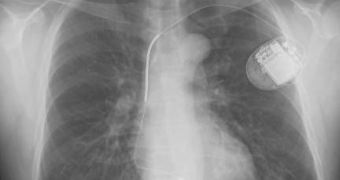Molecular imaging can identify patients that have increased risks of dangerous cardiovascular conditions and so help physicians decide which patients can receive implantable cardioverter defibrillator (ICD) therapy.
For this research, scientists supposed that the causes for heart arrhythmia and sudden cardiac death are the impairment of myocardial perfusion and/or cell viability, and cardiac sympathetic innervations.
They analyzed the prognostic results of cardiac pre-synaptic sympathetic function measured by cardiac MIBG activity and myocite viability or damage given by cardiac tetrofosmin activity in patients treated with the preventive use of ICD, by connecting with lethal arrhythmic events which would have been noted during a prospective follow-up.
This research is the first to show the efficiency of the molecular imaging method for more accurate identification of patients at greater risk of lethal arrhythmia, coronary artery disease and sudden cardiac death.
Kimio Nishisato, M.D., a physician in the cardiology division of Muroram City General Hospital, Muroram, Japan, and a corresponding author for the study said “If the molecular imaging techniques are used for appropriate selection of ICD candidates, not only overuse but also underuse of ICD could be avoided and the assessment may be shown to be more cost-effective.”
Tomoaki Nakata, M.D., PhD, an associate professor at the Sapporo Medical University School of Medicine and director of the Hokkaido Prefectural Esashi Hospital, Japan added that “This research holds significant potential for the detection, diagnosis and treatment of many common cardiovascular conditions.
“With molecular imaging, physicians can improve patient care by pinpointing the precise location of the disease in order to eliminate the need for invasive medical devices and unnecessary surgical techniques.”
Ichiro Matsunari, M.D., PhD, director of the clinical research department at the Medical & Pharmacological Research Center Foundation, Hakui, Japan, and author of an invited perspective also published in the August Journal of Nuclear Medicine stated:
“Sudden cardiac death due to lethal arrhythmia represents an important health care problem in many developed countries [and] while implantable cardioverter defibrillator therapy is an effective option over anti-arrhythmic medications to prevent SCD, the balance of clinical benefits, efficacy and risks is still a matter of discussion.”
He adds that this kind of precise technique is necessary for identifying high-risk patients for SCD, who are most likely to benefit from ICD therapy, as SCD is often the first manifestation of an underlying disease.
This study was published in the August issue of the Journal of Nuclear Medicine.

 14 DAY TRIAL //
14 DAY TRIAL //